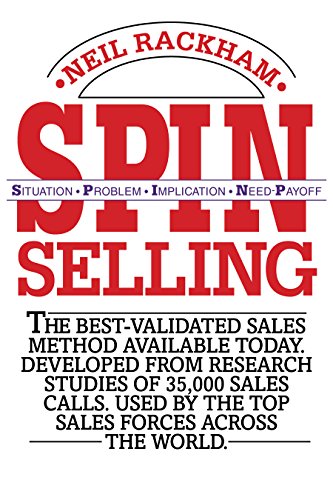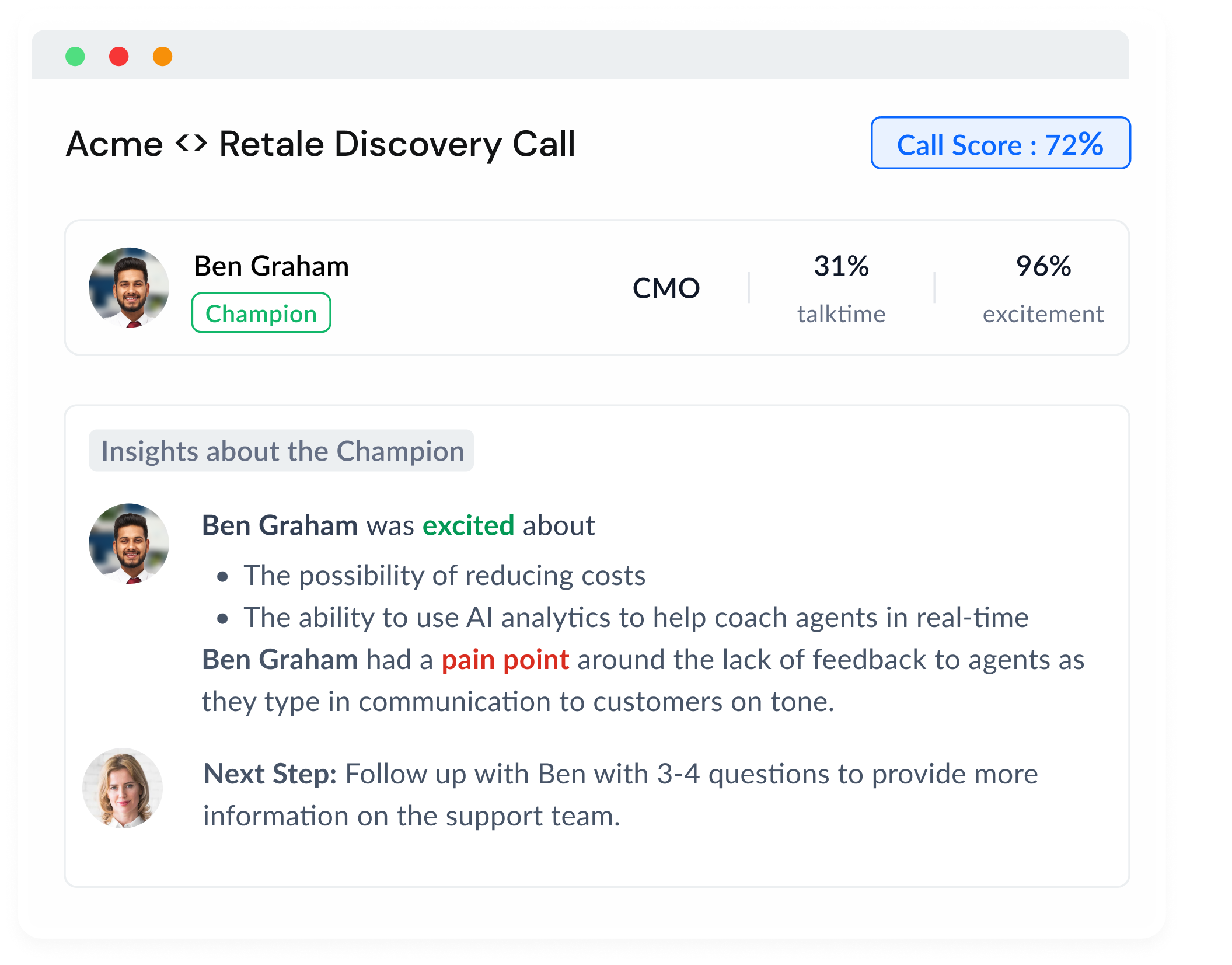Are you a sales leader or a sales rep looking to improve your sales game? If so, you're in the right place. In today's competitive sales world, traditional sales techniques are no longer enough to close deals effectively. That's where SPIN Selling comes in. SPIN Selling is a customer-focused sales method that has been around for over 30 years, but it's still just as relevant today as it was then.
Introduction to SPIN Selling process
SPIN Selling is a consultative sales technique developed by Neil Rackham in the late 1980s, which focuses on understanding the customer's needs and addressing their pain points through a structured questioning process. SPIN is an acronym that stands for:
- Situation
- Problem
- Implication
- Need-Payoff
SPIN Selling is a popular sales method for several reasons:
- Customer-centric approach: The SPIN Selling process emphasizes understanding the customer's needs and pain points, which helps build trust and rapport with the prospect. This customer-centric approach leads to more successful sales outcomes.
- Consultative selling: SPIN Selling encourages salespeople to act as problem solvers rather than pushing their products or services. By focusing on addressing the prospect's issues, salespeople can provide valuable advice and expertise, positioning themselves as trusted advisors.
- Better qualification: The structured questioning process in SPIN Selling helps salespeople qualify prospects more effectively, ensuring that they focus their efforts on the leads that are most likely to convert.
- Higher success rates: SPIN Selling has been proven to be particularly effective in complex or high-value sales, where prospects require more information and assurance before making a purchase decision.
According to research conducted by Neil Rackham, companies that use SPIN Selling have seen an average increase in win rates of 17%, an average increase in deal size of 36%, and an average decrease in sales cycle length of 35%.
The Four Steps of SPIN Selling
The SPIN Selling process revolves around four types of questions that guide the sales conversation and help uncover the prospect's needs. Here's a quick breakdown of each step:
- Situation Questions 🏞️
These questions are designed to gather information about the prospect's current situation, helping you understand their context and needs. Examples include:
- Can you tell me about your current workflow/process?
- How many team members are involved in this project?
- What tools are you currently using for this task?
- Problem Questions ❓
In this phase, your goal is to identify the pain points or challenges the prospect is facing. These questions help you understand the specific problems they're dealing with. Examples include:
- What difficulties are you experiencing with your current workflow?
- Are there any bottlenecks or inefficiencies in your process?
- How does this issue impact your team's productivity?
- Implication Questions 🔮
Here, you want the prospect to consider the consequences of not addressing their problems. Implication questions highlight the potential negative impacts of the issues they're facing. Examples include:
- How does this problem affect your overall business goals?
- What would happen if these issues were left unresolved?
- How much time or money is being wasted due to this problem?
- Need-Payoff Questions 💰
Finally, it's time to position your product or service as the solution. Need-Payoff questions emphasize the benefits of your offering and demonstrate its value to the prospect. Examples include:
- How would it help your team if you could streamline this process?
- What impact would it have on your bottom line if you could solve this issue?
- Can you imagine the time savings if you had a more efficient tool for this task?
By using these four types of questions strategically throughout the sales conversation, the SPIN Selling process guides the prospect from understanding their situation and problems to realizing the implications of those problems and ultimately, seeing the value of your solution. This approach can lead to more successful sales outcomes and stronger customer relationships.
The Fundamental Principles of SPIN Selling
You've nailed the key principles of SPIN Selling! Let's dive into them a little more to get a better understanding:
Understanding the customer's needs 🎯
- SPIN Selling is all about putting the customer at the center of the sales process. By focusing on their needs and understanding their unique situation, you can offer solutions that truly resonate with them, increasing your chances of a successful sale.
Focusing on the customer's problems and pain points 🚧
- Identifying and addressing the customer's problems is at the heart of SPIN Selling. This approach helps you tailor your pitch to show how your product or service can solve their specific issues, making it more relevant and appealing to the prospect.
Building a relationship of trust with the customer 🤝
- By taking a consultative approach and prioritizing the customer's needs, you build rapport and trust with the prospect. This relationship is critical in complex or high-value sales, as it positions you as a valuable partner who can help them overcome their challenges and achieve their goals.
Tailoring the sales pitch to the customer's needs 📢
- One of the core principles of SPIN Selling is to tailor your sales pitch to the customer's unique needs and circumstances. This means focusing on the benefits and value your offering can bring to the prospect, rather than adopting a one-size-fits-all approach. By customizing your pitch, you're more likely to address their concerns and persuade them to take action.
In summary, the fundamental principles of SPIN Selling revolve around understanding the customer's needs, focusing on their pain points, building trust, and tailoring your sales pitch. By adopting these principles, you can create a more customer-centric sales approach that leads to better results and stronger relationships.
Metrics on the Effectiveness of SPIN Selling
When implemented correctly, the SPIN Selling approach can yield several benefits that indicate its effectiveness. Some key metrics that show the positive impact of SPIN Selling on sales performance include:
- Increased win rates 🏆
One of the most important metrics to consider is the success rate of closing deals. Salespeople who use SPIN Selling techniques are often better equipped to address their prospects' needs, which can lead to increased win rates compared to more traditional, product-centric selling approaches.
- Higher deal sizes 💰
Since SPIN Selling focuses on understanding and addressing the customer's pain points, it allows salespeople to offer tailored solutions that deliver more value. As a result, prospects may be more willing to invest in higher-priced packages or add-on services, leading to larger deal sizes and increased revenue.
- Shorter sales cycles ⏱️
By using a consultative approach that centers on addressing the customer's needs, SPIN Selling can help streamline the sales process. Salespeople are better able to identify qualified leads and engage them more effectively, potentially shortening the sales cycle as a result. Moreover, building trust and rapport with the prospect can lead to faster decision-making and reduced time to close.
It's important to note that while SPIN Selling can contribute to these improvements in sales performance, its effectiveness also depends on factors such as the salesperson's skill, the complexity of the product or service being sold, and the overall market conditions. However, with consistent practice and implementation, adopting the SPIN Selling approach can lead to significant enhancements in your sales outcomes.
Which sales teams are best suited to adopt the SPIN Selling process?
The SPIN Selling process is best suited for sales teams engaged in:
- Complex or high-value sales: SPIN Selling is particularly effective when selling products or services that involve a significant investment or require a deeper understanding of the customer's needs. In these situations, prospects often need more reassurance, information, and guidance before making a purchase decision.
- B2B sales: Business-to-business sales often involve multiple decision-makers, longer sales cycles, and complex solutions. SPIN Selling's consultative approach can be highly beneficial in addressing the unique challenges of B2B sales environments.
- Solution-based selling: When your offering is designed to address specific pain points or problems faced by your target audience, SPIN Selling can help you identify and address those issues more effectively.
Common mistakes to avoid:
- Jumping to the pitch too early: In the eagerness to close the deal, some salespeople might try to pitch their solution before fully understanding the prospect's needs. Take the time to ask questions and uncover pain points before offering your product or service as a solution.
- Focusing too much on your product or service: SPIN Selling is about putting the customer first. Avoid excessive product-centric discussions and concentrate on addressing the customer's problems and concerns.
- Not practicing active listening: One of the key components of SPIN Selling is listening to your prospects and understanding their needs. Make sure to actively listen, take notes, and ask follow-up questions to show genuine interest in their situation.
By keeping these guidelines in mind, you can effectively implement the SPIN Selling process and improve your sales outcomes. Remember to choose the right sales strategy based on your specific context, and always prioritize the customer's needs and preferences.
Comparison with Other Sales Strategies
When to use SPIN Selling vs. other sales strategies:
- Use SPIN Selling when you need a structured questioning process to uncover customer needs, especially in complex or high-value sales situations.
- Opt for Consultative Selling if you're aiming to develop a collaborative relationship with the prospect, acting as their trusted advisor throughout the sales process.
- Choose Challenger Selling when you need to disrupt the prospect's current mindset or challenge their assumptions in order to make them more receptive to your offering.
- Pick Solution Selling when your primary focus is on demonstrating the value and ROI of your product or service by directly addressing the customer's pain points.
Each sales strategy has its unique approach and is suited to different situations. Let's compare SPIN Selling with Consultative Selling, Challenger Selling, and Solution Selling:
Consultative Selling:
This approach is similar to SPIN Selling, as it focuses on building relationships, understanding the prospect's needs, and offering tailored solutions. However, Consultative Selling is more about collaborating with the customer and serving as a trusted advisor, helping them make the best decision. It may be less structured than the SPIN Selling process, which relies on specific questioning techniques.
Challenger Selling:
Challenger Selling is a sales strategy where the salesperson takes on the role of a challenger, proactively teaching the prospect, tailoring the solution to their needs, and taking control of the sales conversation. This approach may work well in industries where salespeople need to change their prospects' mindset or challenge their preconceptions. While SPIN Selling focuses on uncovering needs through questioning, Challenger Selling emphasizes providing unique insights and pushing the prospect to think differently.
Solution Selling:
Solution Selling is similar to both SPIN and Consultative Selling, as it aims to address the customer's pain points through tailored solutions. However, Solution Selling places a stronger emphasis on demonstrating the value and ROI of the offering. It often involves identifying specific features or aspects of the product or service that directly address the customer's problems.
It's essential to analyze your sales context, the complexity of your offering, and your target audience to determine the best sales strategy. You may also find that a hybrid approach, combining elements of different strategies, works best for your particular situation.
Conclusion
In conclusion, the SPIN Selling process has become a popular approach for sales teams worldwide because of its customer-centric focus and proven effectiveness. By asking targeted questions to uncover the customer's needs and pain points, salespeople using the SPIN Selling approach can offer tailored solutions that resonate with their prospects, leading to higher win rates, larger deals, and shorter sales cycles. By understanding the four steps of SPIN Selling, the fundamental principles, and the nuances of the method, sales leaders and reps can master this technique and achieve greater success. So why wait?















.png)





